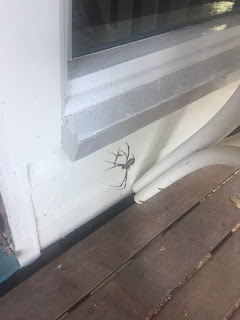What exactly am I doing in Australia?
One of the main answers is sewing bags. I never knew all of those homemaking skills that my mom taught me growing up would come in handy in science, but here I am, sewing bags for our project.
Marc and I joke that it's a sweatshop, but we actually have quite a bit of fun. He's got some pretty good taste in music and we turn up the jams and away we go.
These are the bags that we're sewing. They're made out of this mesh material that is tight enough that termites won't be able to bite through. Some of the bags have holes in them so that termites WILL be able to get through. Our project is looking at different factors that affect how wood decomposes, one of them being the presence/absence of termites. As the designated entomologist for the project, that's the one I'm most interested in. We will put a piece of wood into each bag and weigh it over the coarse of 4 years to see what is having the biggest effect on wood decomposition whether temperature or moisture level or wood type etc... Exciting stuff!
One thing that I've learned in science is how important it is to be organized! Here are some members of our team weighing and labeling our blocks of wood, so that we will be able to make fair comparisons.
Here are just a few of the types of wood we are using for this project. I haven't spent a lot of time thinking about trees, and it's amazing how each tree species has it's own distinct look and smell.
Some of these wood blocks have the most heavenly smells. One of them smelled almost like peaches! We are still trying to figure out what kind of tree has a peachy smell.
I've done quite a bit of insect collecting in the past few years, but I haven't ever really focused on termites, so this is a challenge for me. My protocol for finding termites in the rainforest is this:
1. Find a dead log. This is not usually a problem because in the great circle of life trees are dying all the time and they usually take some time to decompose. Plus, unlike insects, dead logs don't try to fly away or hide.
2. Carefully use a machete to chop into/tear apart/expose inside of log. This is important because there may be snakes or other bad things inside the logs that I do not want to directly come in contact with.
3. Look for termites. This is where it kind of gets hard, because termites don't really like light, so they try to hide very quickly. I think I need to work on my technique a bit. I have tried sucking them up quickly with my pooter (an entomologist's tool for sucking up insects into jars), but I kind of got dirt in my mouth and that was unpleasant. So I normally just go after them with my forceps. But also the termites we are looking for are quite small, and I found I pick up more dirt than termite. So basically, if you know any good tips for looking for termites here, I am open to suggestions.
A much easier way to find termites is when they are in their mounds. Then you just hack into them and can see them running all over the place. Unfortunately, the mound building termites are usually soil or grass feeders and are not as important in wood decomposition purposes.
This beautiful moth Dysphania nomana is called either the peacock jewel moth or the Four o-clock moth. I saw it first in the Daintree forest and then the very next day, a professor from a neighboring lab brought me in one that he had found dead at his house. Shout out to Makani for being my go-to lep person and helping me with the ID.
Another one of the peacock jewel moth.
Here's some wood that I opened up looking for termites. Can you find the surprise?
Yeah that was a little scary.
So there are these green ants all over the place here in Queensland. You can actually eat them and they taste like green apple--I guess the acidity is some kind of defense? But in the forest, I saw this amazing behavior where they glue these leaves together to make homes. Here they are also eating some kind of giant grasshopper. They are amazing.
And here is a bunch of green ants cooperating together to move this beetle. I thought this would make a good motivational poster.
Another termite mound.
This is a Cassowary, the terrifying big birds that live in the Daintree forest. They are apparently pretty dangerous, especially if they have young. One walked across the path only a few feet behind us. This picture is from google, but that's what they look like in real life.
Here's an amazing veggie burger I ate at the university. See https://dcveggieburgers.blogspot.com for the full story.
The temperature has been lovely and here is some cloud cover on the forest behind the university.
Cool bird at the university.
Gecko in my house. It spooked me a bit when I was opening the blind.
I like that the yield signs here say "Give way".
I think Andrea ate her last suitor, but here's another. I hope it goes better for him.
Cool Caterpillar.
There are beautiful trails really close to the place I'm staying. This is the ocean view from the top of the red arrow.
This is a huntsman spider from the family Sparassidae that surprised us when we went down to the washer yesterday. Never a dull moment!



















































